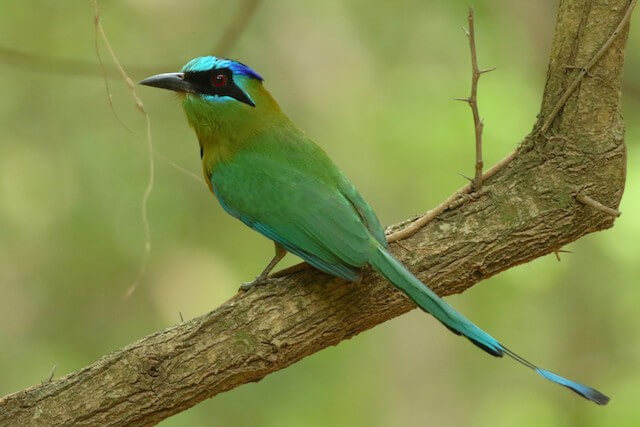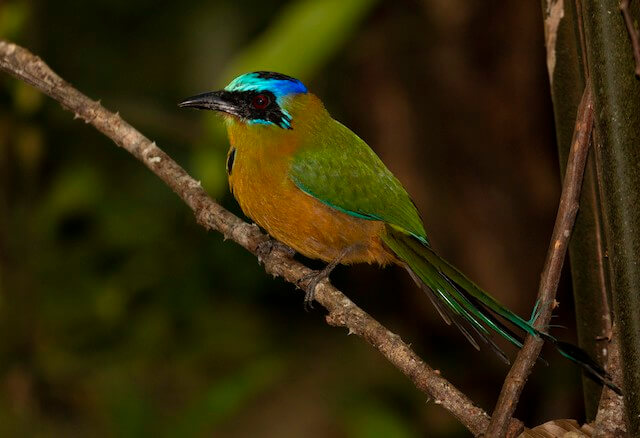Amazonian Motmot: Habitat and Characteristics

The Amazonian motmot (Momotus momota) is a bird belonging to the Coraciiformes order, which includes the bee-eaters, and the Momotidae family. It has a wide distribution and a varied diet. If you want to know everything about this colorful bird, read on.
Habitat and distribution of the Amazonian motmot
It’s a bird with a very wide distribution, ranging from southern Mexico, Bolivia, Brazil, Colombia, Ecuador, Peru, Paraguay, Venezuela, Guyana, and as far north as Argentina. The Amazonian motmot generally inhabits tropical areas with some watercourse nearby.
They can live in a wide range of altitudes, ranging from sea level to 3000 meters (9800 feet) above sea level. In terms of vegetation, it usually inhabits the edges of wet or dry forests, preferably those with some kind of ravine. It has also been seen near human settlements, such as crop fields or mining areas.

Physical characteristics
The Amazonian motmot stands out for its vivid coloration. It usually measures 40 cm (nearly 16 inches) in length, although there are some that are longer. It has a large and robust head with a strong curved beak.
The beak of these birds has a serrated and sharp edge from the nostrils to the tip, which could be mistaken for teeth. It’s believed that they have it this way due to their varied diet.
The plumage is mainly green, although in the ventral areas it has olive and brown colors. They have a turquoise blue crown surrounded by a black crown. The eyes and cheeks have a black mask. The tail is long and has green colors ending in blue. The end of the tail ends in two rachises, with feathers in the form of blue and black racquets.
Behavior of the Amazonian motmot
The Amazonian motmot is a mainly solitary bird, except when it’s with its mate. In addition, they’re sedentary birds, which, once settled, don’t leave their territory, unless conditions require it. It tends to make numerous deep vocalizations.
They have diurnal habits and are fairly quiet birds, unless they’re looking for a mate, in breeding season, or defending their territory. They have been seen associated with livestock in search of dung beetles, and with squirrel monkeys to capture insects that fly in their path.
Subspecies of the Amazonian motmot
Nine subspecies of these birds are known, which are differentiated mainly by the areas of distribution in which they live:
- Momotus momota microcephalus: in the lowlands of the Andes, western Venezuela, eastern Ecuador and northeastern Peru and Brazil.
- Momotus momota momota: from the Orinoco River to the Guianas and northern Brazil.
- Momotus momota ignobilis: eastern Peru and northern Bolivia.
- Momotus momota simplex: northern Brazil south of the Amazon river.
- Momotus momota cametensis: from the lower Xingu River to the Tocantins River.
- Momotus momota parensis: northeastern Brazil.
- Momotus momota marcgravianus from Paraíba to Alagoas, in northeastern Brazil.
- Momotus momota nattereri: north and center of Bolivia.
- Momotus momota pilcomajensis: eastern and southern Bolivia and northeastern Argentina.
Diet and reproduction
The Amazonian motmot is an omnivorous bird. It feeds mainly on invertebrates, with a great predilection for beetles. They also eat fruit, reptiles, chicks from other nests, and other small mammals.
Scientific observations of this species have shown that they sometimes capture large prey such as rats, and that nest predation is more common than previously thought.
It is believed that their beak is shaped like it is to make it easier to catch these larger prey to tear them apart better. To find food, it flies from a low position. Sometimes it can be dropped to capture animals on the ground.
As for reproduction, the Amazonian motmot builds its nests in holes dug in slopes. Both members of the pair are responsible for incubating the eggs and caring for the chicks.
The breeding season usually begins with the rainy season, when food is most abundant. They form monogamous pairs that court by giving the males some food to the females. If accepted, the pair is formed.
They usually lay three eggs, although nests with two and five have been seen. Incubation lasts between 29 and 32 days, although this may vary according to altitude and weather conditions. Chicks are born naked and grow at a very fast rate in the first week of life. Chicks usually leave the nest within a month of hatching and continue to be fed by their parents for some time thereafter.
Conservation status

The Amazonian motmot is a bird categorized by the IUCN as a species of least concern. The main danger is habitat destruction due to anthropogenic causes. The main threats are deforestation, agriculture, cattle ranching, urban development, tourism, and poor exploitation of resources, which fragment their habitat.
All cited sources were thoroughly reviewed by our team to ensure their quality, reliability, currency, and validity. The bibliography of this article was considered reliable and of academic or scientific accuracy.
- Korzun, L. P., Érard, C., & Gasc, J. P. (2004). Morphofunctional study of the bill and hyoid apparatus of Momotus momota (Aves, Coraciiformes, Momotidae): implications for omnivorous feeding adaptation in motmots. Comptes rendus biologies, 327(4), 319-333.
- Reid, J. L., & Gutiérrez, A. S. (2010). Observaciones de dos presas nuevas de vertebrados para el momoto común (Momotus momota). Zeledonia, 14(2), 68-72.
- Información obtenida el día 22807/2021 en la web de la UICN: https://www.iucnredlist.org/species/61634607/95173087
This text is provided for informational purposes only and does not replace consultation with a professional. If in doubt, consult your specialist.